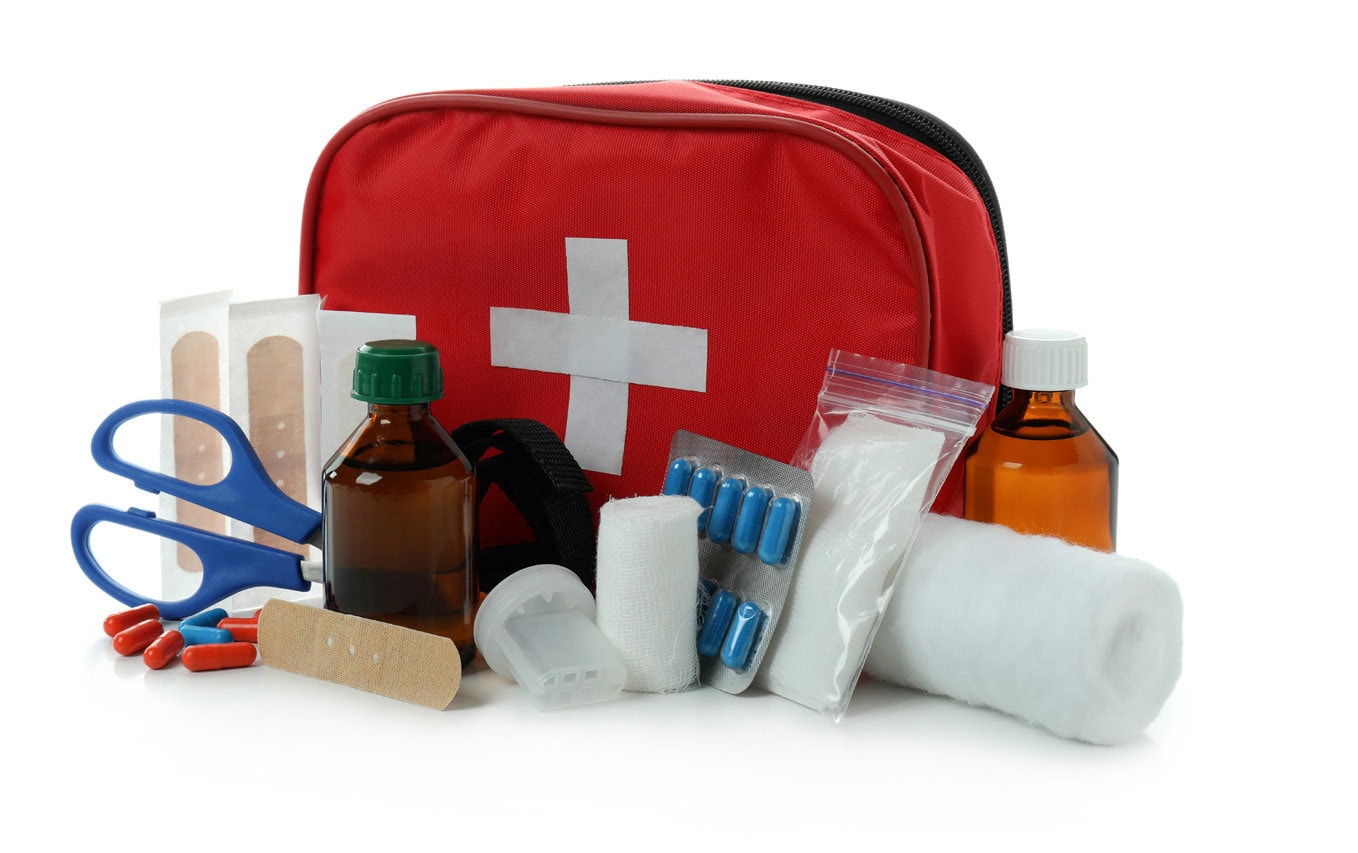Key Takeaways
- A well-equipped first aid kit should include a variety of bandages, gauze pads, and dressings for effective wound treatment.
- Essential medications such as antibacterial ointment, painkillers, and emergency medications must be included to manage pain and prevent infections.
- Including tools like scissors, tweezers, and a thermometer, along with first aid instructions, enhances preparedness for emergency medical situations.
1. Bandages and Band-Aids

One of the most fundamental components of any home first aid kit is a variety of bandages and Band-Aids. These items are indispensable when it comes to treating minor cuts, scrapes, and blisters. Having an assortment of sizes and types ensures that you can adequately cover and protect wounds of various shapes and sizes.
Including latex-free options in your kit caters to those with sensitivities. Using tape to secure wound dressings keeps them in place and prevents further injury. Regularly changing gauze pads promotes healing and minimizes the risk of infection.
Include sharp, medical-grade scissors for efficiently cutting bandages and tape. With these essentials, you’ll be well-equipped to handle minor injuries at home.
2. Gauze Pads and Dressings
Gauze pads and dressings are the unsung heroes of first aid kits. These versatile supplies come in various sizes to accommodate different types of wounds, ensuring proper coverage. Using absorbent dressing helps to control bleeding and protect the wound from infection, making them a key component of any kit.
Sterile gauze pads are particularly important as they reduce the risk of contamination during treatment. Correct application of bandages prevents further injury and promotes better healing. Having a diverse selection of bandages allows for effective treatment tailored to various injuries. Additionally, duct tape can be an effective tool for securing dressings firmly in place when traditional bandages aren’t available.
Different types of bandages serve specific roles in first aid application. For instance, some are designed for compression to control swelling, while others are more suitable for securing dressings in place. Having a variety of bandages prepares you for any minor medical scenario.

3. Antibacterial Ointment
Antibacterial ointment is a must-have in any first aid box as it plays a crucial role in preventing major infections in minor cuts and skin abrasions. These ointments typically contain ingredients like Bacitracin, Neomycin, and Polymyxin B, which facilitate healing and protect minor wounds from infection.
Storing antibiotic ointment properly maintains its effectiveness. Keeping it in a cool, dry place ensures a prolonged shelf life, so it’s always ready when you need it. Single-use packets of antibiotic ointment minimize the risk of cross-contamination and promote hygiene.
Having antibiotic ointment on hand allows for quick treatment of minor wounds and prevention of potential complications. This small addition to your healthcare kit can make a significant difference in the healing process.

4. Pain Relievers

Pain relievers are an indispensable part of any home first aid kit. Common choices include acetaminophen, aspirin and ibuprofen, which are effective in managing pain and reducing fever. These medications should be stored in your kit to ensure they are readily available when needed.
Verify any known allergies before administering pain relief medications to avoid adverse reactions. These medications are particularly essential for treating pain from injuries, making them a vital component of your emergency medical kit.
Painkillers in your own first aid kit allow you to address pain symptoms promptly and effectively. This preparedness can make a significant difference in managing injuries and ensuring comfort during emergencies.
5. Scissors and Tweezers
Every first aid kit should include scissors and tweezers. Scissors are used for cutting dressings, bandages, and tape, ensuring you can tailor the materials to the wound size. Opting for blunt-tip scissors is recommended to prevent accidental injuries while cutting.
Tweezers, on the other hand, are crucial for removing splinters, ticks, or stingers, which can cause further complications if not addressed promptly. Including these tools in your kit ensures that you can handle a variety of minor medical situations with precision and care.

6. Non-Latex Gloves
Non-latex gloves protect both the caregiver and patient from potential infections. These gloves are particularly important for individuals who are allergic to latex, ensuring that everyone can be treated safely.
Single-use gloves ensure hygiene and minimize the risk of cross-contamination during treatment. A pair of these gloves helps maintain a sterile environment while providing care.
7. Thermometer
Monitoring body temperature can indicate illness or the need for medical attention. Digital thermometers are particularly suitable for children and infants as they provide quick and accurate readings.
Certain types of thermometers, like mercury ones, are being phased out due to safety concerns regarding mercury exposure. Instead, infrared and temporal artery thermometers offer a safer and faster alternative by simply swiping across the forehead.
Ensuring digital thermometers have functioning batteries guarantees accurate temperature readings. A reliable thermometer in your first aid kit helps you monitor your health effectively and respond promptly to concerns.

8. Hydrocortisone Cream
Hydrocortisone cream is effective in alleviating swelling, itching, and redness associated with skin irritations. It’s particularly useful for treating symptoms caused by insect bites and allergic reactions.
Applying a thin layer of hydrocortisone cream to the affected area can provide quick relief from discomfort. Avoid eye contact and follow proper application guidelines for safety.
9. Emergency Medications

Emergency medications are crucial in a first aid kit. Aspirin is important for addressing chest pain, while antihistamines like diphenhydramine are crucial for treating allergic reactions. These medicines prepare you to handle severe emergencies.
Personalize emergency medications based on the specific medical needs of family members. For instance, having an auto-injector of epinephrine is vital for those at risk of severe allergic reactions.
Remember, certain groups should avoid aspirin, including children, those allergic to it, those with bleeding issues, and those on blood thinners. Having the right emergency medicines in your kit can be life-saving in critical situations.
10. First Aid Instructions

A printed first-aid guide in your kit assists in delivering effective care during emergencies. These instructions, recommended by organizations such as the American Red Cross, can provide step-by-step guidance on how to handle various injuries and provide emergency medical help effectively.
A first-aid guide can also help you avoid common pitfalls, such as administering aspirin to children, which can be dangerous unless prescribed by a healthcare professional. This resource equips you to provide accurate and timely care.
Other Essentials
In addition to the basics, consider carrying a few other essential items to make your first aid kit truly versatile. Items like alcohol wipes and hand sanitizer are crucial for maintaining hygiene while treating wounds, especially when you’re on the go or in your car. For households with children, having the right supplies on hand can make all the difference during emergencies.
Keep remedies for potential heart attack symptoms or unexplained chest pain easily accessible—every second counts in these situations. Additionally, including the contact information for poison control and your local fire department is invaluable during accidental ingestions or emergencies. Don’t forget to carry extra water, which can be essential for cleaning wounds, rehydration, or taking medications.
By stocking your kit with the following items, you’ll be better prepared to handle unexpected situations and ensure the safety of your family members.
Summary
To sum up, a well-stocked first aid kit is essential for every home. From bandages and gauze pads to emergency medications and first aid instructions, each item plays a crucial role in ensuring that you can handle minor medical emergencies effectively.
By being prepared with these essential supplies, you can provide immediate care, prevent complications, and ensure the well-being of your family members. Now is the time to gather these items and create a comprehensive first-aid kit that will serve you well in times of need.
For more detailed and comprehensive information, explore the American Red Cross guide on building a first aid kit.
Looking for a variety of first aid kit options at flexible prices? Visit our store here!
Frequently Asked Questions
Why is it important to have a variety of bandages in a first aid kit?
It is crucial to have a variety of bandages in a first aid kit to effectively treat different types of injuries, ensuring proper coverage and protection. This tailored approach enhances the overall effectiveness of injury management.
What are the benefits of including antibacterial ointment in a first aid kit?
Including antibacterial ointment in a first aid box is essential as it prevents infections in minor cuts and abrasions, promoting efficient healing and safeguarding against complications.
Why should non-latex gloves be included in a first aid kit?
Non-latex gloves are essential in a first aid kit as they prevent allergic reactions in those sensitive to latex and offer protection against infections for both the caregiver and the patient.
What types of painkillers should be included in a first aid kit?
It is essential to include acetaminophen, aspirin and ibuprofen in a first aid kit to effectively manage pain and reduce fever. Choosing these common painkillers ensures preparedness for various situations.
Why is it important to have a printed first-aid guide in a first-aid kit?
Having a printed first-aid guide in a first-aid kit is essential as it offers clear, step-by-step instructions for managing injuries and emergencies, thus ensuring prompt and effective care. This resource can be crucial in high-stress situations where quick decision-making is vital.



